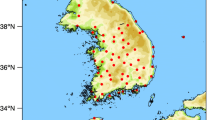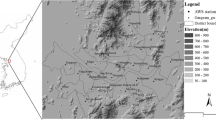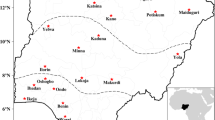Abstract
In Seoul (37.57°N, 126.97°E), South Korea (located at mid-latitudes), the frequency of tropical night (TN) days, which have been defined as days with a minimum temperature greater than 25°C, have shown an increase due to the effects of temperature and water vapor. It was found that TN days accounted for almost 10.2% (July) and 22.1% (August) of the total number of days in respective months during the last decade in Seoul, and these figures may be increasing with climatic change. The daytime and nighttime sky on TN days can contain water vapor when the monsoonal southwesterly flow prevails. This strong wind may induce moisture advection from the warm ocean, and consequently, there is much larger specific humidity over the city during TN days in comparison to non-TN days. The effect of climatic change on the specific humidity is related to an increase in the number of TN days, which has shown an upward trend of 13-day/100-year and is significantly modulated by both water vapor and air temperature during July and August. Moreover, the relative role of water vapor in increasing the frequency of TN days has become much more significant after the 1960s in comparison to that of air temperature, which may be attributed to urbanization in Seoul since the 1960s.













Similar content being viewed by others
References
Alexander L, Zhang VX, Peterson TC, Caesar J, Gleason B, Tank AMG, Klein HM, Collins D, Trewin B, Rahimzadeh F, Tagipour A, Ambenje P, Kumar K, Rupa RJ, Griffiths G, Vincent L, Stephenson D, Burn J, Aguilar E, Brunet M, Taylor M, New M, Zhai P, Rusticucci M, Vazquez-Aguirre JL (2006) Global observed changes in daily climate extremes of temperature and precipitation. J Geophys Res 111:D05109. doi:10.1029/2005JD006290
Easterling DR, Horton B, Jones PD, Peterson TC, Karl TR, Parker DE (1997) Maximum and minimum temperature trends for the globe. Science 277:364–367
Gaffen DJ, Elliott WP, Robock A (1992) Relationship between tropospheric water vapor and surface temperature as observed by radiosondes. Geophys Res Lett 19:1839–1842
Ha K-J, Jeon E-H, Oh H-M (2007) Spatial and temporal characteristics of precipitation using an extensive network of ground gauge in the Korean Peninsula. Atmos Res 86:330–339
Ha K-J, Shin S-H, Mahrt L (2009) Spatial variation of the regional wind field with land-sea contrasts and complex topography. J Appl Meteorol Climatol 48:1929–1939
Heo I, Kwon W-T (2007) Temperature change of recent 10 years (1996–2005) in Korea. Clim Res 2(2):79–93 (in Korean)
Heo S-J, Ha K-J, Moon S-E (1997) Characteristic features of the East Asian summer monsoon during 1993 and 1994. J Korean Meteorol Soc 33:737–751 (in Korean)
Kalnay E et al (1996) The NCEP/NCAR 40-year reanalysis project. Bull Amer Meteor Soc 77:437–471
Karl TR, Kukla G, Razuvayev VN, Changery MJ, Quayle RG, Heim RR Jr, Easterling DR, Fu CB (1991) Global warming: evidence for asymmetric diurnal temperature change. Geophys Res Lett 18:2253–2256
Kendall MG (1975) Rank correlation measures. Charles Griffin London: pp 202
Kim YH, Baik JJ (2004) Daily maximum urban heat island intensity in large cities of Korea. Theo Appl Climatol 79:151–164
Kwon M, Jhun J-G, Ha K-J (2007) Decadal change in east Asian summer monsoon circulation in the mid-1990s. Geophys Res Lett 34:L21706. doi:10.1029/2007GL031977
Mann HB (1945) Nonparametric tests against trend. Econometrica 13(245):259
Peng S, Huang J, Sheehy JE, Laza RC, Visperas RM, Zhong X, Centeno GS, Khush GS, Cassman KG (2004) Rice yields decline with higher night temperature from global warming. Proc Natl Acad Sci U S A 101:9971–9975
Shukla J (1981) Dynamical predictability of monthly means. J Atmos Sci 38:2547–2572
Trenberth KE et al (2007) Observations: surface and atmospheric climate change. In: Solomon S et al (eds) Climate change 2007: the physical science basis. Contribution of working group I to the fourth assessment report of the intergovernmental panel on climate change. Cambridge University, Cambridge, United Kingdom and New York, NY, USA
Um H-H, Ha K-J, Lee S-S (2007) Evaluation of the urban effect of long-term relative humidity and the separation of temperature and water vapor effects. Int J Climatol 27:1531–1542
von Storch H, Zwiers FW (1999) Statistical analysis in climate research, 1st edn. Cambridge University Press, Cambridge, pp 181–191
Vose RS, Easterling DR, Gleason B (2005) Maximum and minimum temperature trends for the globe: an update through 2004. Geophys Res Lett 32:L23822. doi:10.1029/2005GL024379
Willits DH, Peet MM (1998) The effect of night temperature on greenhouse grown tomato yields in warm climates. Agric For Meteorol 92:191–202
Acknowledgments
This work was funded by the Korea Meteorological Administration Research and Development Program under Grant CATER 2011-2212.
Author information
Authors and Affiliations
Corresponding author
Rights and permissions
About this article
Cite this article
Ha, KJ., Yun, KS. Climate change effects on tropical night days in Seoul, Korea. Theor Appl Climatol 109, 191–203 (2012). https://doi.org/10.1007/s00704-011-0573-y
Received:
Accepted:
Published:
Issue Date:
DOI: https://doi.org/10.1007/s00704-011-0573-y




